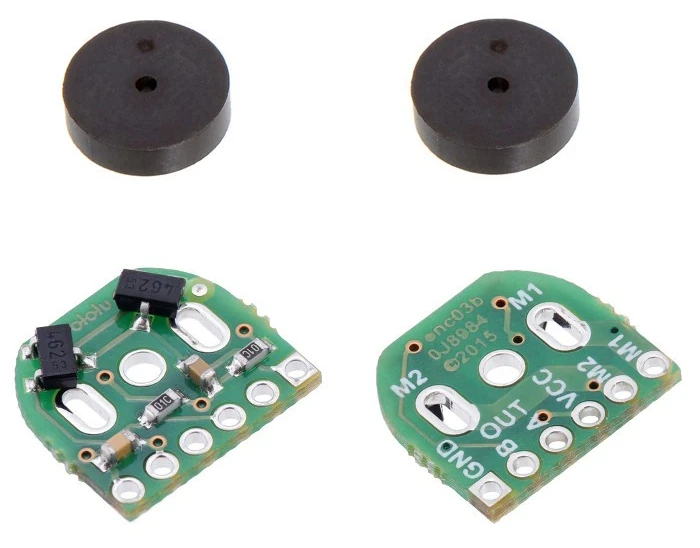Table of Contents:
In a world dominated by technology, precision and efficiency have become key features, driving innovation in all industries.
Continuous advances in precision electronics are opening up new possibilities, improving our lives and work.
At the center of this technological revolution is a humble but indispensable component – the magnetic encoder.
While it may not be as recognizable as, for example, microprocessors, its role in precise motion monitoring and control is absolutely crucial. Find out exactly what a magnetic encoder is, how it works and where it is most often used in practice.
What is a magnetic encoder?
A magnetic encoder is an electronic device designed to convert mechanical motion into electrical signals using the properties of magnetic fields. The basis of its operation is the interaction between a moving magnet and a magnetic sensor, which allows precise monitoring of the position, direction and speed of machine components.
A magnetic encoder consists of four components:
- magnet,
- magnetic sensor,
- electronic system,
- Housing.
The key component encoder is a magnet, whose movement relative to the sensor induces changes in the magnetic field, which are then recorded as electrical signals. These signals, when processed appropriately, provide information about the motion parameters, enabling their precise control.
The magnet, usually made of high remanence materials, is mounted on a rotating shaft or moving component.
A magnetic sensor, often using the Hall effect, responds to changes in the magnetic field caused by the movement of the magnet. An electronic circuit converts the received signals into digital data, providing the information needed to control the system.
What types of magnetic encoders are distinguished?
The variety of applications for magnetic encoders has necessitated the development of different types of encoders, each of which is adapted to the specific requirements of a given application. There are two main types: absolute and incremental encoders.
Absolute magnetic encoder
These models are designed to assign a unique signal to each position, making it possible to identify the absolute position of an axis at any time, without the need to refer to any starting point. A key advantage of absolute encoders is their ability to retain position information even when power is lost, making them indispensable in applications where high reliability and safety are required.
Incremental magnetic encoder
Incremental models generate a series of signals with each movement made, allowing position changes to be tracked relative to a specified starting point.
Although they do not provide direct absolute position information, they are simpler to construct and often less expensive than absolute encoders, making them widely used in many motion control systems.
What is a magnetic encoder used for?
Magnetic encoders, thanks to their precision, reliability and resistance to harsh environmental conditions, are used in a wide range of fields. Their ability to precisely track the position, speed and direction of mechanical components makes them indispensable in many modern control and monitoring systems.
Here are some of the most important areas of use for magnetic encoders:
- Industrial automation – In industry, magnetic encoders are a key component of automation systems, providing precise positioning and motion control of machines.
They are used in production lines, where they control the movement of conveyor belts, industrial robots and other machines, as well as in CNC machines, where precise tracking of tool positions is crucial for machining accuracy.
- Automotive and Transportation – The magnetic encoder plays an important role in the automotive industry and in transportation systems.
It is used to monitor the speed of wheels and drive shafts, which is crucial for ABS and traction control systems, as well as the precise positioning of components in steering systems. - Renewable energy – in the renewable energy sector, magnetic encoders contribute to the efficiency and reliability of systems such as wind turbines, where they enable precise tracking of blade position and angle, optimizing energy efficiency, or solar panel tracking systems, where they control the angle of the panels relative to the sun, maximizing energy production.
- Medical and healthcare – Magnetic encoders are used in a wide range of advanced diagnostic and therapeutic devices, including MRI scanners, where accurate position tracking is crucial for precise diagnostic images.
They are also encountered in radiation therapy devices, where positioning of the patient and radiation source must be extremely precise to effectively treat cancerous tissue with minimal damage to healthy tissue. - DIY projects – Magnetic encoders are also finding their way into the world of DIY electronics.
Due to their availability, versatility and ease of integration, they are a popular choice among hobbyists working on individual projects.
They can be successfully integrated with Arduino or Raspberry Pi modules. They can be used, for example, in the field of robotics – from simple educational robots to advanced constructions.
What are the characteristics of magnetic encoders?
The magnetic encoder stands out from other solutions in this area, such as optical models, among others.
in terms of resistance to harsh environmental conditions. Unlike optical versions, which are sensitive to contamination and require a clean operating environment, the magnetic encoder retains its functionality even in the presence of dust, moisture or oil, making it an ideal choice for industrial and automotive applications.
How useful was this post?
Click on a star to rate it!
Average rating 0 / 5. Vote count: 0
No votes so far! Be the first to rate this post.




















